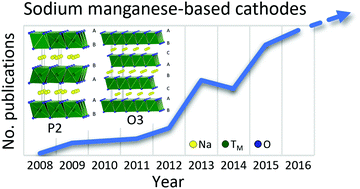High performance manganese-based layered oxide cathodes: overcoming the challenges of sodium ion batteries
Abstract
Currently, there is increasing interest in developing ‘beyond lithium’ battery technologies to augment, or in certain situations replace, lithium ion batteries (LIBs). Room temperature sodium ion batteries (NIBs) offer an attractive combination of low cost and plentiful constituents and a wide range of phases, structures and stoichiometries available for optimisation. Sodium layered oxides are considered to be promising candidates as cathode materials, due to their flexibility and versatility, as well as their intrinsically fast structural diffusion of Na ions which leads to enhanced rate capability. In particular, sodium manganese based layered oxides (generally NaxMn1−y−zMyTMzO2, where TM represents one or more transition metals, and M consists of one or more non-transition metals) are a key family of materials, in part due to the relatively low cost and environmentally friendly nature of the manganese, and consequently are worthy of a detailed investigation. Examination of these systems, particularly in terms of stoichiometry and phase, has shown that significant advances have been made recently, both in terms of understanding the mechanisms behind electrochemical performance, and in terms of refining these to produce improved materials. The goal of this review is to present the current developments in sodium manganese based layered oxides (particularly with respect to electrochemical performance, physical properties and manganese content), to discuss the current state of this field of research and to draw conclusions regarding where future investigations may be most fruitfully directed.



 Please wait while we load your content...
Please wait while we load your content...